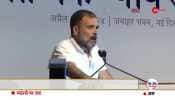New Delhi: At a time when the Ayodhya issue is back in spotlight ahead of the Uttar Pradesh Assembly elections next year, a book penned by a former IPS officer has claimed that the Ram temple in Ayodhya was demolished during the reign of Aurangzeb and that of Babar, contrary to the common beliefs.
The book 'Ayodhya Revisited' penned by former Gujarat cadre IPS officer of 1972 batch Kunal Kishore, quotes texts from old files during British period and ancient Sanskrit texts and reviews of archaeological excavation and attempts to project that the Ram Janmabhoomi temple did exist in Ayodhya before a mosque was built on it.
The book also propounds a new thesis about the period of the mosque's construction and seeks to demolish earlier beliefs on the issue.
The book says the demolition of the temple did not take place in 1528 AD (during Babar's regime) but in 1660 AD when Fedai Khan was the Governor of Aurangzeb in Ayodhya.
Kunal has held the inscriptions on the disputed site to be fake and tried to prove that the conclusions drawn by a number of historians on the basis of it are wrong.
"It is wrong to say that Babar ordered the demolition of the Ram Janmabhoomi Temple at Ayodhya. He never visited Ayodhya. The claim of the historians that Mir Baqi, the then governor of Awadh, got the Babri mosque constructed in 1528 is fictitious," he says.
He goes on to argue that Mughal rulers right from Babur to Shahjahan were quite liberal and extended patronage to all religions.
"All the Mughal emperors from Babur to Shahjahan were magnanimous and liberal rulers and the Bairagis of Ayodhya enjoyed patronage of the first four nawabs of Awadh.
"However, during the long rule of Aurangzeb, the country was engulfed in the fire of fanaticism," Kunal says in the book.
Kunal argues that Babar under no circumstances visited Ayodhya or ordered demolition of the Ram Janmabhoomi Temple there. He says that the claim of historians that Mir Baqi, the then governor of Oudh, had the Babri mosque built in 1528 is also fictitious.
He has also quoted from Father Joseph Tieffenthaler, an Australian traveller who visited India and remained here for more than two decades, that he was told by the locals that the demolition was carried out by Aurangzeb.
Quoting Sanskrit, English and French scholars, Mr Kunal has tried to establish that a temple did exist at the site in question at Ayodhya.
The author has heavily relied upon literary sources of foreign travel accounts and archaeological excavation reports.
In the foreword, Mr Patnaik says the accounts of Western scholars Thomas Herbert, Joannes De Laet and C Mentelle have been produced for the first time while writing the history of Ayodhya.
"It is a historical fact that until the British takeover of Awadh administration in 1858, both the Hindus and Muslims used to perform puja and offer Namaz respectively," he says.
The author has expressed hope that this book will transform the thinking of people on the Ayodhya issue and remove the toxin of communal canard in the country. Accusing historians of both shades "established" and "enthusiasistic", euphemism for historians with left-wing and right-wing orientations, of having done "injustice" to the writing of history on Ayodhya dispute, Mr Kunal claims that through this book he has tried to "expose" them.
Claiming that the existence of a temple at the disputed site in past is based not on beliefs but on impeachable evidence, he claims that this also found an echo in the judgement of the Allahabad High Court and hoped that it will now put quietus to the disquieting dispute.
The book has come at a time when politics is in full swing for the Uttar Pradesh elections.
BJP lawmaker Subramanian Swamy recently said the construction work for the temple will start soon, while Union Minister Uma Bharti has said the issue of there being a Ram Janmasthan at the site was now a settled issue after the Allahabad High Court said undisputedly that the dome in the middle is of Ramlalla.
Bharti has claimed the dispute now remains was only over land which can be resolved through dialogue or legislation.
In September 2010, a three-judge bench of Allahabad High Court, comprising Justices SU Khan, Sudhir Agarwal and DV Sharma, had ruled that the disputed land be split into three parts. It had said that the portion below the central dome under which the idols of Ram and other gods were placed, belonged to Hindus.
(With inputs from PTI)
















